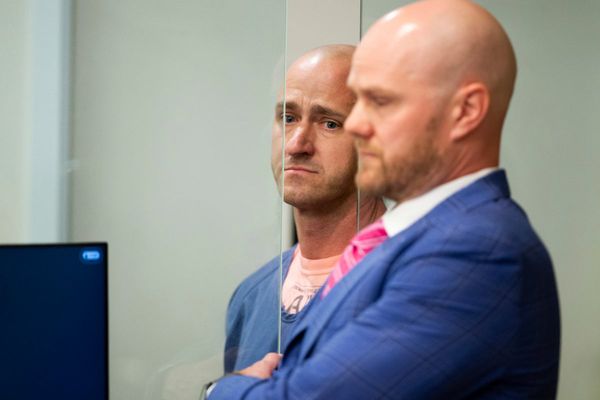Updated September 15 at 7:58 a.m. EDT
In the early morning hours on Friday, Cassini cruised into Saturn’s upper atmosphere at tens of thousands of miles per hour, getting closer to the planet than ever before. The bus-sized orbiter, jostled by the dense atmosphere, fired its thrusters to keep its antenna pointed at Earth and transmitted data about the unexplored territory. The atmospheric forces quickly became too powerful, and Cassini began to tumble. It deployed emergency procedures to try to stabilize itself, but it was no use. Cassini started to break apart and disintegrated over Saturn’s cloud tops, like a meteorite streaking across the sky.
About 80 minutes later, Cassini’s final signals reached antennas on Earth. The spacecraft’s end, a spectacular light show on Saturn, played out on computer screens. The display resembles a heart monitor, with a skinny green spike signaling the strength of Cassini’s signal against a black background. At about 7:55 a.m. EDT, after 13 reliable years, the spike shrank and vanished.
“I feel like I’m going to a hospice, watching somebody’s EKG, and waiting for their last heartbeat to come,” said Dick French, the principal investigator on the radio-science team responsible for talking to Cassini, said in the days before the plunge. “It’s going to be wrenching.”
French and several hundred mission members gathered at NASA’s Jet Propulsion Laboratory in California this week to witness the “loss of signal,” a bittersweet end to a $3.26 billion mission. Before its final dive, Cassini was running out of fuel. Scientists and engineers decided long ago that when the time came, they would crash the spacecraft into Saturn in an attempt to protect some of the ringed planet’s moons, particularly Enceladus and Titan, from earthly debris. Unlike Saturn, Enceladus and Titan are good candidates for harboring microbial life and NASA wants to keep them uncontaminated by humanity. In April, Titan’s gravity nudged Cassini into a trajectory that took the orbiter between Saturn and its rings, from which there was no return but only, as NASA puts it, a “grand finale.”
Cassini’s performance began in the early 1980s, when NASA and the European Space Agency convened groups of scientists to brainstorm a potential joint mission to Saturn. Proposals were solicited and submitted, and the U.S. Congress approved funding in 1989. Many members of the Voyager expedition, which was nearing the end of its decade-long tour of the outer planets, joined the mission. NASA would build the Cassini spacecraft, and ESA would build a lander called Huygens, destined for Titan, Saturn’s largest moon. In 1990, scientists held their first big meeting at JPL. “I don’t know if any of us could fathom at the time how extremely successful the mission would be,” said Bill Kurth, the principal investigator on the radio and plasma wave science team, which studies the environment around Saturn.
Perhaps that was because the Cassini mission faced its greatest perils before it even left Earth. Each new year brought another round of potential budget cuts from Congress and fears that the project wouldn’t survive. The partnership with ESA, which was pouring millions of its own money into the project, made Congress less willing to gut it. “We were in this mission with the Europeans in what I would call the sink-or-swim mode,” said Darrell Strobel, an interdisciplinary scientist who has worked on the mission since 1983. “If either side withdrew its support for this mission, it would have been a failure.”
In 1992, NASA leadership, facing budget cuts, told engineers to rework their designs for the spacecraft to reduce costs by millions of dollars. Engineers removed platforms that would have allowed scientific instruments to move and point independently of each other, which meant the entire spacecraft would have to pivot to line up an experiment. As Cassini prepared to launch in 1997, protests sprang up over the mission’s use of plutonium-238, a fuel that can be used to build nuclear weapons or, in Cassini’s case, power a robot. Some worried that if Cassini were to explode during launch, the radioactive substance would be sprinkled through the air for miles.
Despite the controversy, the launch—plutonium-238 and all—went perfectly. “When you finally saw the thing leave ground, it’s honestly a miracle it happened,” Strobel said. Scientists spent the seven-year cruise to Saturn carefully planning out observations, how much time each team would get and when. Cassini was like a car with a camera glued to the hood. If scientists wanted to get a look at anything, engineers would have to steer the entire spacecraft over. “We could orbit Saturn this way or that way, and this would give us a chance to look at this moon, but then we couldn’t look at that moon, which would you like better?” French said. “Learning how to work with other teams as collaborators one day and as competition the next day for a different set of observations required that we develop political skills that not every scientist is born with.”
In 2000, scientists decided to take a sneak peek at Jupiter as Cassini flew past, using the gas giant’s gravitational pull as a boost. Scientific instruments were supposed to stay off until Cassini arrived in Saturn’s orbit, but where’s the fun in that? “So what we told NASA with a wink and a nod—that’s the way things are done—was ‘Well, this isn’t a science mission. We’re going to test out the instruments at Jupiter,’” said Mike Flasar, the principal investigator for Cassini’s composite infrared spectrometer, which measures infrared light to study the temperature and composition of objects.
Engineers spent years preparing for worst-case scenarios for Cassini’s entrance into Saturn’s orbit in July 2004, but the insertion went off without a hitch. After years of budget scares and hardware tweaks and plutonium protests, they were finally there. “I remember coming back in the morning just to catch those pictures as they were shown on the screen one by one,” said Linda Spilker, Cassini’s lead scientist. She felt she could almost “reach out and touch a ring particle.” Spilker has worked on Cassini for nearly 30 years, which, she points out, equals almost a single Saturn year.
In December 2004, Cassini released Huygens over Titan. For three weeks the lander was silent as it parachuted down. Jonathan Lunine, an interdisciplinary scientist, was inside a trailer in Germany with other scientists when the first photos came back to Earth. For several minutes, thumbnail after thumbnail flashed across their computer screens of alien surface. “We’d get a picture from a high altitude that didn’t really show anything, it was too hazy, and then suddenly we get a picture of gullies, which we didn’t know existed,” said Lunine, who has studied Titan since the early 1980s. “I screamed when I saw those.” On Earth, gullies are etched into rocky landscapes by flowing water. On Titan, they’re created by liquid methane.
Lunine and other scientists spent hours molding the thumbnails into a mosaic of a new world. “Being in isolation with these 20 other people in the middle of winter, in the middle of the night after this long day, putting together this mosaic of an alien world which I had wanted to see for over 20 years, I kind of began to get the feeling that I wasn’t in a trailer in Darmstadt, Germany,” he said. “I was in a trailer on the surface of Titan.”
The Huygens lander’s batteries died two hours after it touched town. Cassini went on to unleash what Spilker describes as a fire hose of information about the ringed planet and its moons. The spacecraft revealed, through stunning images and careful measurements, hurricanes on Saturn, methane lakes and seas on Titan, and water-vapor plumes erupting on Enceladus. French remembers conducting an experiment that required bouncing a radio signal off a Titan lake that, if it were smooth enough, would reflect the transmission directly at antennas on Earth. “Imagine that you’re driving a car toward the sun and you look at the hood of your car and you see the reflection bouncing off of the hood—that’s what we were trying to do,” he said. When it worked, French fell out of his chair.
The Cassini mission was only supposed to last four years. It was extended in 2008 for another two years, and again in 2010, this time until its fuel ran out. Strange as it may sound, the plan to crash Cassini into Saturn provided an exciting opportunity. The team didn’t need to be careful with it anymore. “The engineers, who’ve been so conservative and so cautious for decades, are allowing us to use the spacecraft in ways that would just have been too dangerous, to go places we never would have been allowed—in between the rings and close to the planet’s upper atmosphere and close to the edge of the known rings—and turn the spacecraft and do maneuvers with it that never would have been allowed,” said Larry Esposito, the principal investigator of ultraviolet-imaging spectrograph, which uses ultraviolet light to create images and study gases.
“It wasn’t a death spiral,” he said. “It was a new beginning.”
Cassini has returned some strange observations from its latest orbits. Scientists are getting “almost physically impossible" readings for the dynamics of the planet’s gravitational field, which they don’t yet understand, according to one researcher. The dust particles floating between the planet and its rings are tinier than they expected, and the atmosphere is denser than they predicted. They’re seeing all sorts of structures inside Saturn’s rings—clumps and streaks and waves—they didn’t expect to find.
Mission scientists will spend the next few years analyzing this data, looking for clues to some of Saturn’s biggest mysteries. Even after a 13-year trip to Saturn, humans still don’t know how massive its rings are, a measurement that could help reveal their age. Esposito, who has studied the planet’s ring system for more than 40 years, hoped Cassini’s final plunge would provide some answers.
But first, humanity had to say goodbye. After years of anticipation, the end was quick, almost jarring. In its silence, Cassini’s stewards will go on with their days. Some mission members said they would get breakfast when it was over. Others plan to drive over to a big party at the California Institute of Technology during the day, and then to a soiree at someone’s home that night. Earl Maize, Cassini’s program director, said he might help take his grandchildren to school. His 7-year-old granddaughter recently gave him an origami Saturn. Maize wonders at how little the world knew about Saturn nearly three decades ago, and how much his grandkids know now.
“Saturn for them now is this dynamic, alive place,” Maize said. “And who knows, by the time they’re my age, what Saturn and the rest of the solar system’s going to look like.”







